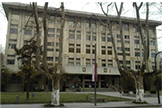
Recently, the research group led by Professor Wang Jinlan of School of Physics SEU made great progress in the growth of van der Waals epitaxy of two-dimensional materials. The team proposed a new strategy to protect black phosphorus from degradation that is to use self-assembled organic monolayers by van der Waals epitaxy based on multi-scale simulation. The research result “Passivation Black Phosphorus via Self-Assembled Organic Monolayers by van der Waals Epitaxy” was published in Advanced Materials, top material advanced journal, Impact Factor 18.96.
In recent years, black phosphorus, a new type of two-dimensional semiconductor material consisting of elemental phosphorus, has attracted worldwide interest because of its unique physical and chemical properties. However, its fast degradation in the air hinders its practical application severely. Based on first principle and molecular dynamic simulation, and the organic molecule perylene tetracarboxylic dianhydride as the representative of the study, the team proposed to a use self-assembled organic monolayer by van der Waals epitaxy to protect black phosphorus from degradation. Advantages of this method are that it does not break the original properties of black phosphorus and that it affords new idea of protecting other two-dimensional materials lack of air stability. First author of the study is Zhao Yinghe, doctoral students of School of Physics SEU. Professor Wang Jinlan is the corresponding author.
The research is funded by The National Science Fund for Distinguished Young Scholars, Jiangsu Science Fund for Distinguished Young Scholars and Specialized Research Fund for the Doctoral Program of Higher Education of China.
















